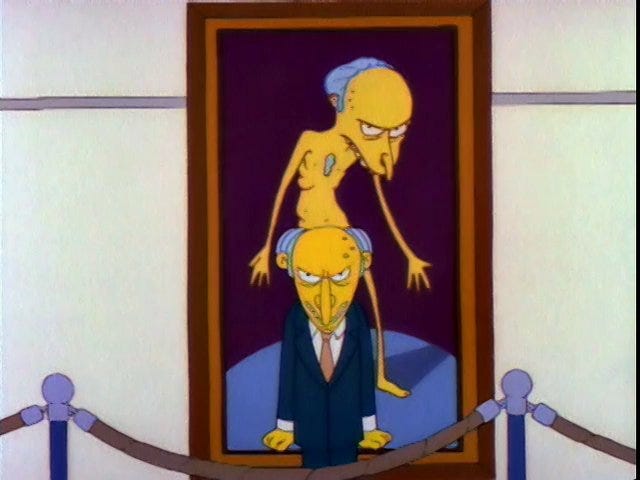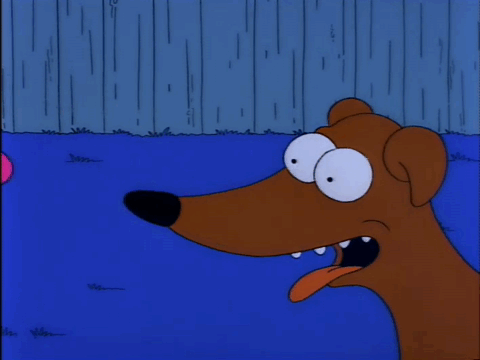S2E18: A Brush with Greatness
Will you take us to Mount Splashmore? Will you take us to Mount Splashmore? Will you take us to Mount Splashmore? Will you take us to Mount Splashmore? Will you...
Here is one of the more repulsive sentences in the English language, championed only by ‘Milk, milk, lemonade, round the corner…’ and ‘Hey, do you like me as more than just a cousin?’:
‘Lately, I’ve been thinking about my writing a lot.’
The seas are rising, the polar bears are dying, the top 1% own 50% of the world’s wealth, and lately, I’ve been thinking about my writing a lot.
I worry people (all 20 of you) think I love The Simpsons. That this daily practice is an expression of that love. It is not. If you want to be a better writer (which I do), you have to read a lot (which I don’t). You learn a lot from reading good books, and a lot more from reading bad books. There are lessons in The Simpsons, and there’s a lot of good, and a lot of bad, to learn from. As long as you’re willing to equate watching The Simpsons to reading books.
So, what’s the lesson of A Brush With Greatness? Exceptional storytelling, fully integrated. A Brush with Greatness has what strikes me as a near-mathematical perfection in the execution of its narrative. No singular Simpson is under-utilised (relative to their stature, sorry Maggie) and each plot point serves to explore a real and important theme. There are no yucks for yuck’s sake. The act structure is clearly defined, yet seamless, like a series of chain links forming a small, smooth shirt of mithril.
Act one ‘Mount Splashmore’: The Simpson family (prompted by The Krusty show and the kids’ insistent nagging) decide to go to Mount Splashmore (think Wet’n’Wild, but animated). Along the way, Homer’s weight is alluded to in the stretched nature of his boardshorts, the collision of his belly with the horn when he gets in the car, and ultimately his en-stuckening within the H2Whoa! waterslide. Footage of Homer being removed via crane on the local news is a sufficient embarassment to prompt Homer into losing some weight.
Act two ‘Homer’s die(t)’: Homer goes into basement to find his exercise equipment where he also discovers water colours painted by Marge in her youth, depicting the first Beatle to appear on The Simpsons: Ringo Starr. While Homer works out, Marge exercises her creative muscles, with Lisa supporting her once fierce passion for painting, and to a lesser extent, Ringo.
Act three ‘Marge paints Burns’: Marge is commissioned to paint C. Montgomery Burns, challenged to bring out his inner beauty. Storyline A (Marge painting) intersects with storyline B (Homer’s diet) when Burn’s mocks Homer’s quest to quell. Having built her practice on the idea that there is beauty in everyone and everything, Marge says there is no beauty in Mr Burns, and gives up on painting.
Until! She receives a letter from Ringo (who’s diligently working through a backlog of fan mail).
Best read in a nasally, Liverpudlian accent:
Dear Marge....
Thanks for the fab painting. I hung it on me wall.
You're quite an artist. Yes, we do have hamburgers and fries in England, but we call French fries ‘chips.’
Love, Ringo.
Ps: Forgive the lateness of my reply
Re-inspired, Marge paints Burns the way she see’s him. Frail, mortal. Real.
Top to tail, A Brush with Greatness is a fully-integrated story, and there is distinction in this. It sounds clinical, but it’s harmony. A captivating system.
High-level, there’s the theme of inner beauty. Burn’s craves it externally, Homer searches for it internally. Mid-level, there’s a story which moves credibly from Mount Splashmore, to community college (where Marge studies art), to Ringo Starr’s study, to Marge’s debut. Low-level, there’s characters sufficiently understood by the writers to support the levels above. Marge’s ability to see beauty in everyone—articulated here for the first time, but once you’re aware of it, apparent in so many episodes before this one. Homer’s embarrassment, you wouldn’t expect it of a slob, but it humanises him when the cards are down. Lisa’s kinship with her mother, as a fellow artist. Bart’s…continued rogue-ish behaviour.
The lesson of A Brush with Greatness is that it’s easy to tell a joke, but it’s hard to tell a story. A joke only requires a set-up and a punchline. A story requires so much more, multi-factored, multi-levelled components, working in tandem across structures. A Brush with Greatness does both.
Review: 4/5
Since last we spoke…
S2E16 Bart’s Dog Gets an “F”(4/5):
The second episode of season two to contain the words ‘Bart’, ’Gets’ and ‘an F’. Lisa has the mumps and Santa’s Little Helper destroys Homer’s brand-new $125 sneakers (how quickly we forget that Homer is a sneakerhead). He also destroys the Simpson’s quilt, handed down through seven generations. The decision is made that if SLH doesn’t pass obedience school, he won’t be a Simpson anymore. A choke chain symbolises how unfair it is to punish the stupid. Dogs, and Barts, sometimes just don’t know better.
S2E17 Old Money (3.5/5):
Abe falls in love with a fellow retirement home resident. In a classic Swartzweldian twist (a term I’m coining, meaning: unexpected, yet believable), following her unexpected yet timely demise, Bea Simmons leaves her enormous wealth to Abe, and it becomes a ‘What if Grandpa was rich episode?’. While it’s not a John episode (S2E17 is one of Jay Kogen and Wallace Wolodarsky’s), it’s easy to see Swartzwelder’s influence as story editor. We haven’t had an Abe episode since John’s Simpson premiere Bart the General and it’s nice to see that Abe’s friendship with Herman hasn’t gone by the wayside. This is the first episode to feature Professor Frink, and, if you’re ever cornered in an alley by Tom Gleeson, the only episode where the voice artists’ names appear next to their characters in the credits.
In a moving scene, Abe looks at his worn and wrinkled hands (animated in higher fidelity than the standard yellow appendage) and decides to spend his money renovating the retirement home. ‘Dignity’s on me, friends.’








